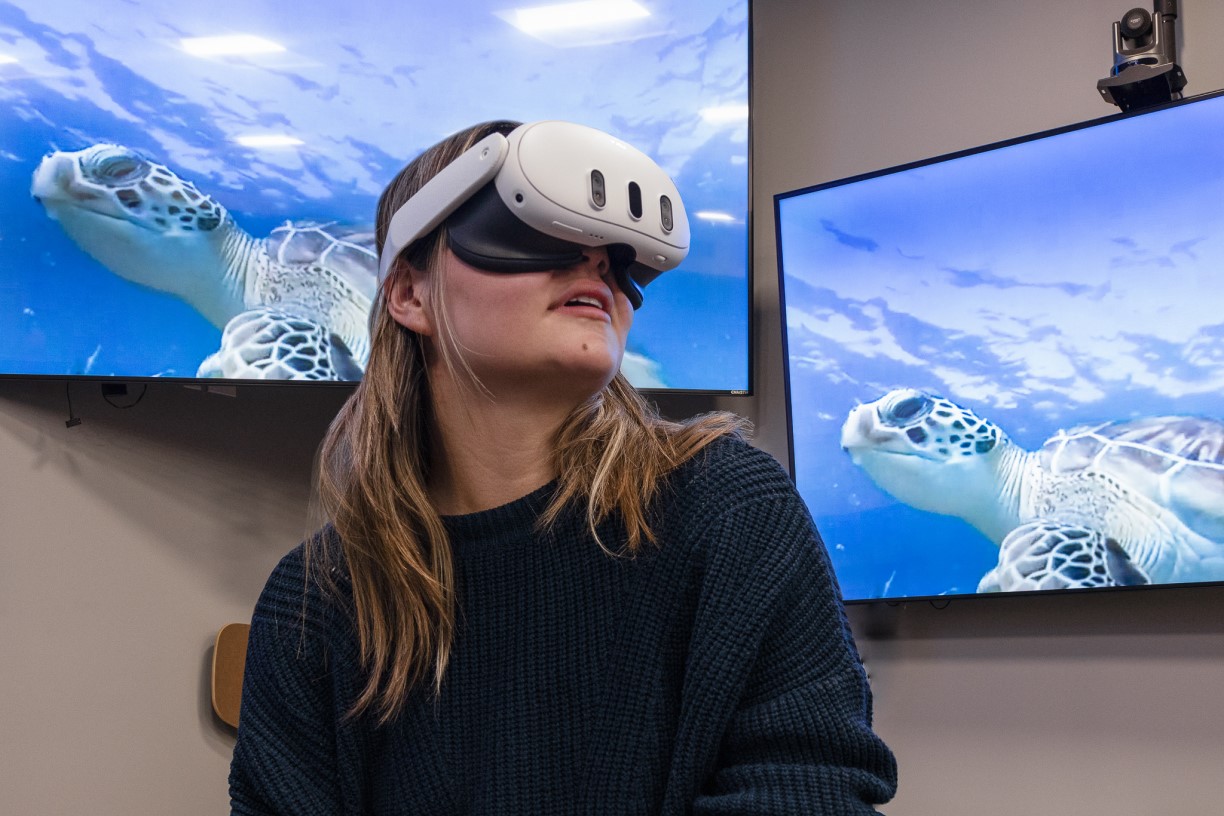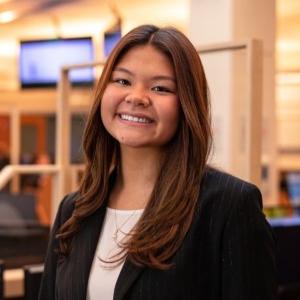
(Under) Sea Change: Virtual Reality and Aquatic Exploration
Caroline Chang ’24 never imagined that her senior year at Bentley would include close-up encounters with green sea turtles, southern stingrays and other fascinating aquatic creatures that dwell in the coastal waters of the Bahamas.
But that’s exactly what the double major in Management (with a concentration in Entrepreneurship) and Liberal Studies: Earth, Environment and Sustainability experienced in her Oceanography (NAS 340) course this fall. Fully immersed in the crystalline waters of the Caribbean Sea, Chang watched in wonder as a sea turtle swam through the undulating leaves of a seagrass meadow and a stingray glided by overhead, showing off its sleek white underbelly. Making these aquatic encounters even more remarkable? She experienced them from the comfort of her Bentley classroom — no plane ticket, passport or swimsuit required.

Instead, Chang and her fellow Falcons were able to explore diverse marine environments by donning virtual reality (VR) headsets and engaging with fully immersive, 360-degree digital videos produced by Betsy Stoner, an assistant professor of environmental science. The videos — created with footage filmed in south Florida and the Bahamas, where Stoner conducts much of her research — mark the first time in Bentley’s history that a VR experience produced entirely by university faculty and staff has been used for classroom instruction. “The coolest thing about it was the feeling of being there in person,” Chang says of the experience. “I felt like I was scuba diving and had a front-row seat to all of the action!”
And that, says Stoner, is precisely the point. For the past three years, she’s brought Bentley students to the Bahamas through “From Shore to Sea: Understanding Caribbean Ecosystems & Their Services” (NAS 3900), a research-focused international course she developed in partnership with the university’s Cronin Office of International Education. The experience offers students a powerful, firsthand look at how human-initiated impacts — including climate change, overfishing and industrial pollution — threaten the island nation’s coastal ecosystems and the lives and livelihoods of Bahamians who depend upon them. Providing hands-on learning activities “helps students engage more deeply and meaningfully with the course material than they ever could with a textbook,” Stoner explains. But since she can’t bring every student to the Caribbean, she opted for the next best thing: bringing the Bahamas back to Bentley through VR-mediated undersea explorations.
RELATED: Prof. receives NSF grant to explore ‘ecological memory’ in Bahamas
The videos were created as part of a multi-year, National Science Foundation grant Stoner and colleagues from Florida International University (FIU) and the Louisiana Universities Marine Consortium (LUMCON) received to study the role of “ecological memory” in sub-tropical seagrass beds. Stoner enlisted Bentley colleagues Jon Ericson, an associate professor of Experience Design (XD), Steve Salina ’91, principal engineer for instructional media and Gaurav Shah, senior director of Bentley’s Academic Technology Center (ATC) and User Experience Design, to help film and edit the videos, which Salina produced using Warp VR, an all-in-one creator platform for immersive learning.
The research team wrote scripts for a series of videos that explore three distinct marine environments — mangroves, seagrasses and hard-bottom habitats — and reveal fascinating facts about each, from the peculiar (nutrients in fish urine are essential for maintaining the health of coral reefs) to the profound (seagrass, the only flowering plant that blooms underwater, is a natural climate change combatant due to its ability to sequester, or store, high levels of carbon).

Stoner also received project support from Bentley’s Office of Diversity and Inclusion through an IDEA Innovation Grant, which provides funding for programs and initiatives that foster cross-cultural dialogues and enhance learning focused on diversity, equity and inclusion (DEI). As Stoner explains, “Countries in the Global South, such as the Bahamas, contribute minimally to global climate change but feel the effects of it more acutely, through intensified storms and sea level rise, than countries in the Global North,” a concept known as climate injustice. The Bentley grant made it possible for the team to interview a local conch fisherman in the videos, she explains, noting that first-person accounts like these help students better understand how “marginalized communities, including those that live along coasts and rely heavily on natural resources like conch, are disproportionally affected by climate change and the loss of those resources.”
Beyond the content featured, immersive VR experiences like Stoner’s can also address educational inequities. As Chang observes, “Incorporating VR in the classroom gives all students, regardless of their socioeconomic status, the ability to virtually travel the world and experience other cultures and environments. It helps make valuable educational experiences more accessible in schools where resources are limited, and field trips or site visits aren’t always feasible.” That’s one reason why Stoner and her co-researchers have made the videos available via their own website and through Warp VR; to date, educators in other states, including Alabama and Florida, have used the modules in courses for high school and college students.

Through a longstanding partnership Stoner has with Friends of the Environment, a Bahamas-based nonprofit dedicated to environmental education and conservation, the researchers will also help residents and visitors learn about the islands’ ecosystems. The organization, which offers afterschool programs, summer camps and other STEM-based educational activities for Bahamian youth, will feature the videos as a permanent exhibit in its new Exploratorium.
“We’re always looking for new and exciting ways to get people interested in and excited about issues of biodiversity and conservation,” says Olivia Patterson-Maura, deputy director of Friends of the Environment. “The VR experience will offer more opportunities for learning about nearshore habitats, particularly for those with different learning styles and physical abilities who may not be able to access them otherwise.”
The fully immersive medium, Patterson-Maura adds, will also help students learn about the importance of preserving marine ecosystems in a fun and interactive way. “An important part of what we do is fostering personal connections with the environment,” she says of the organization. “We find that students involved in our programs are more likely to participate in other environmental activities and become more engaged and informed citizens. What’s more, their actions have a positive, trickle-down effect on their families and friends.”
Chang agrees. “The immersive experience that VR offers creates a deeper connection between students and the material they’re learning about,” she says. “For example, we all know that global warming is harming our planet, but these videos allow students to see with their own eyes the damaging effects of climate change on marine ecosystems.
“For a topic as important as ecological change in the 21st century,” Chang continues, “finding a way to get students invested in the material is essential for motivating them to initiate changes — both as individuals and business leaders — that will have a positive impact on the planet.”


